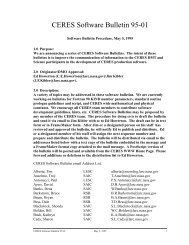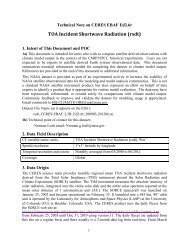Response of Deep Convective Clouds to Increases in ... - ceres
Response of Deep Convective Clouds to Increases in ... - ceres
Response of Deep Convective Clouds to Increases in ... - ceres
Create successful ePaper yourself
Turn your PDF publications into a flip-book with our unique Google optimized e-Paper software.
<strong>Deep</strong> convective clouds frequently occur with heavyaerosol burdens <strong>of</strong>f the west coast <strong>of</strong> Africa dur<strong>in</strong>g theseason <strong>of</strong> biomass burn<strong>in</strong>g.CALIPSO 532-nm attenuated backscatter, 13 August 2009 1430 UTC
Three years <strong>of</strong> CERES SSF from Terra used <strong>to</strong>obta<strong>in</strong> the properties <strong>of</strong> deep convective cloudscollocated with large aerosol burdens.CERES: <strong>Clouds</strong> and Earth’s Radiant Energy SystemSSF: S<strong>in</strong>gle Satellite Footpr<strong>in</strong>t• The SSF comb<strong>in</strong>es retrievals <strong>of</strong> aerosol and cloudproperties based on MODIS radiances with radiativefluxes derived from the CERES broadband radiometers.• Each CERES footpr<strong>in</strong>t is ~20 km resolution at the Earth’ssurface.
<strong>Deep</strong> convective clouds frequent the Pacific Warm Pool, theNorth Indian Ocean, the west coast <strong>of</strong> Africa, and SouthAmerica.<strong>Deep</strong> convectivesystems were soughtbetween 60° S <strong>to</strong> 60° N.Sherwood (2002) andJiang et al. (2008)reported f<strong>in</strong>d<strong>in</strong>g effects<strong>of</strong> aerosols on deepconvective clouds overSouth America.
<strong>Deep</strong> convective clouds and heavy aerosol burdensoccur primarily <strong>in</strong> the Northern Indian Ocean, Africa,and South America.
Properties <strong>of</strong> deep convective clouds collocated with largeaerosol burdens are compared with those collocated with smallaerosol burdens.SMALLLARGEFollow<strong>in</strong>g Loeb andSchuster (2008), for eachday obta<strong>in</strong> meanproperties <strong>of</strong> deepconvective clouds andmean aerosol burdens <strong>in</strong>each 2°× 2° lat.-lon. region.SMALLLARGEDivide the 2°× 2° regionswith<strong>in</strong> a 10°× 10° region<strong>in</strong><strong>to</strong> those with meanaerosol optical depthsgreater than the mean forthe 10° region and thosewith optical depths lessthan the mean.Correlate differences <strong>in</strong>cloud properties withdifferences <strong>in</strong> aerosoloptical depths.
<strong>Deep</strong> convective clouds show nochanges with <strong>in</strong>creased aerosol burdens.Difference = Large − Small
Ice crystal diameterand cloud opticaldepth <strong>in</strong>crease withdecreas<strong>in</strong>g cloudtemperature.
<strong>Deep</strong> convective cloudsexhibit relationships amongtheir properties.The least-squares fits were calculatedus<strong>in</strong>g statistically <strong>in</strong>dependent FOVs.The means and standard errors wereobta<strong>in</strong>ed for equal populations (10 thpercentiles) <strong>of</strong> the cloud optical depthand 11-μm brightness temperature.The coldest b<strong>in</strong> consistently had thelargest optical depths and the smallestice crystal diameters <strong>in</strong> all regions andall seasons.The largest optical depth b<strong>in</strong>sconsistently showed a decrease <strong>in</strong> icecrystal diameter with <strong>in</strong>creas<strong>in</strong>g cloudoptical depth.
<strong>Deep</strong> convective cloudsexhibit relationships amongtheir properties.The least-squares fits were calculatedus<strong>in</strong>g statistically <strong>in</strong>dependent FOVs.The means and standard errors wereobta<strong>in</strong>ed for equal populations (10 thpercentiles) <strong>of</strong> the cloud optical depthand 11-μm brightness temperature.The coldest b<strong>in</strong> consistently had thelargest optical depths and the smallestice crystal diameters <strong>in</strong> all regions andall seasons.The largest optical depth b<strong>in</strong>sconsistently showed a decrease <strong>in</strong> icecrystal diameter with <strong>in</strong>creas<strong>in</strong>g cloudoptical depth.
Monthly mean ice particle diametersappear <strong>to</strong> decrease with <strong>in</strong>creas<strong>in</strong>gmonthly mean aerosol burdens.The changes <strong>in</strong> ice particle diametersare also consistent with the lowertemperatures observed dur<strong>in</strong>g theseason with <strong>in</strong>creased aerosol load<strong>in</strong>g.Sherwood (2002) also found lowercloud <strong>to</strong>p temperatures l<strong>in</strong>ked <strong>to</strong>smaller ice crystal sizes.Perhaps previous studies claim<strong>in</strong>gaerosol effects were observ<strong>in</strong>g the<strong>in</strong>crease <strong>in</strong> small ice crystals withdecreas<strong>in</strong>g temperatures.
Monthly mean ice particle diametersappear <strong>to</strong> decrease with <strong>in</strong>creas<strong>in</strong>gmonthly mean aerosol burdens.The changes <strong>in</strong> ice particle diametersare also consistent with the lowertemperatures observed dur<strong>in</strong>g theseason with <strong>in</strong>creased aerosol load<strong>in</strong>g.Sherwood (2002) also found lowercloud <strong>to</strong>p temperatures l<strong>in</strong>ked <strong>to</strong>smaller ice crystal sizes.Perhaps previous studies claim<strong>in</strong>gaerosol effects were observ<strong>in</strong>g the<strong>in</strong>crease <strong>in</strong> small ice crystals withdecreas<strong>in</strong>g temperatures.
Summary<strong>Deep</strong> convective clouds appear <strong>to</strong> be unaffected by collocated elevated burdens <strong>of</strong>aerosols <strong>in</strong> regions where deep convective clouds and large aerosol burdens occurfrequently: South America and western Africa dur<strong>in</strong>g biomass burn<strong>in</strong>g and theNorthern Indian Ocean dur<strong>in</strong>g the w<strong>in</strong>ter and summer monsoons.Ice crystal diameter and cloud optical depth appear <strong>to</strong> <strong>in</strong>crease with decreas<strong>in</strong>gcloud temperature presumably due <strong>to</strong> large numbers <strong>of</strong> supercooled cloud dropletsbe<strong>in</strong>g l<strong>of</strong>ted above the freez<strong>in</strong>g level by strong updrafts <strong>in</strong> deep convective clouds(e.g. Garrett et al. 2003 and Garrett et al. 2007, and Heymsfield et al. 2009).Previous studies claim<strong>in</strong>g evidence for the effect <strong>of</strong> aerosols on clouds (Sherwood2002; Jiang et al. 2008, and Jiang et al. 2009) focused on South America whereclouds have lower cloud <strong>to</strong>p temperatures and smaller ice crystals dur<strong>in</strong>g theseason <strong>of</strong> biomass burn<strong>in</strong>g.Perhaps, the effect <strong>of</strong> aerosols is <strong>to</strong> suppress warm cloud precipitation therebyfacilitat<strong>in</strong>g deeper convection form<strong>in</strong>g clouds with lower temperatures andsmaller ice crystals (Andrae et al. 2004).
















